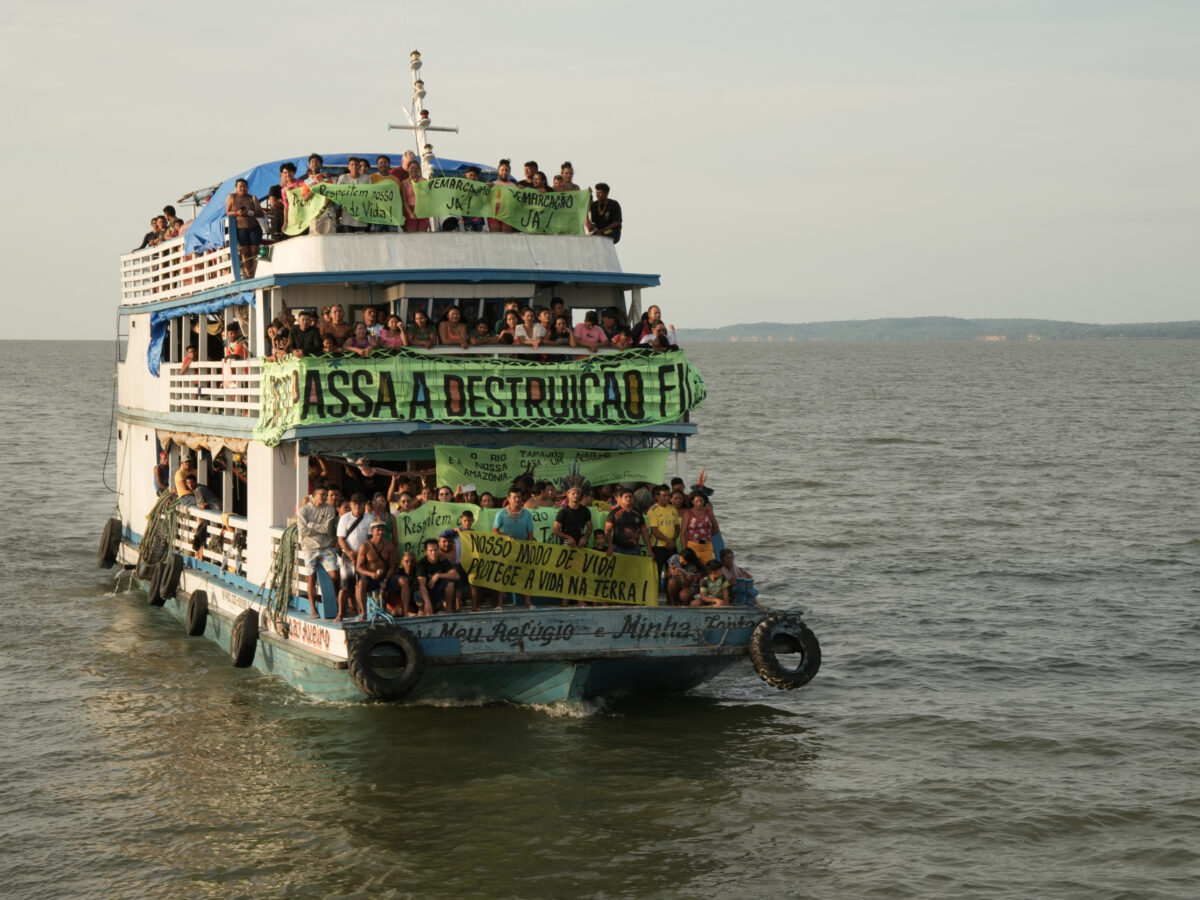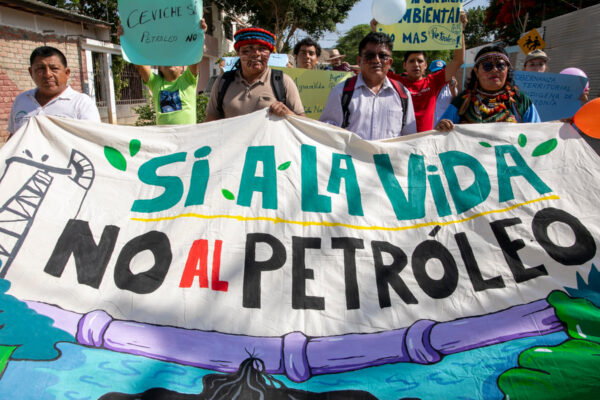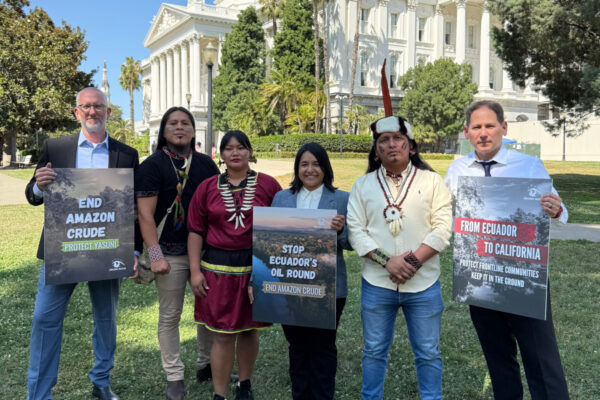Photos available here (Credits: Coletivo Apoena Audiovisual)
If you are a journalist covering COP30 (in person or virtually) and would like to join our WhatsApp group where we will share relevant information, contact us here.
Santarém (Pará, Brazil) – While world leaders debate climate policy in Belém (PA), more than 300 Indigenous people and allies from social movements held the 8th Ancestral Cry on the Tapajós River, in the Lower Tapajós region of western Pará. The peaceful action took place within Tupinambá Territory, inside the Tapajós-Arapiuns Extractive Reserve, and included a symbolic occupation of cargo barges, protesting against the expansion of the Arco Norte waterway system and the proposed Ferrogrão railway (EF-170).
Over the course of five hours, four support vessels and six smaller boats surrounded three soy barge convoys, while Indigenous leaders climbed onto the structures holding banners that read “No to Ferrogrão,” “Food Without Poison,”and “Agro Passes, Destruction Stays.”
The protest remained entirely peaceful and public, serving as a powerful statement from Indigenous and traditional communities across the Amazon and Cerrado about the impacts of Brazil’s grain export corridors on rivers, fisheries, territories, and local livelihoods.
“The Ancestral Cry is our message to the leaders of the world,” said Marília Sena, a Tupinambá leader. “We don’t want our biomes to be seen only as markets or transport corridors for soy, ports, and railways. We want people to see those who have been here for centuries, caring for the forest and the river. Preserving the Tapajós is a condition for any serious climate commitment.”
Tapajós at the center of Brazil’s waterway expansion
The protest took place on one of the most strategic rivers in Brazil’s infrastructure agenda. The Tapajós River begins in Mato Grosso, flows through Pará, and joins the Amazon River near Santarém. Its basin represents about 6% of the entire Amazon watershed and it is home to Indigenous peoples, Afro-descendant quilombola communities, riverine families, and major conservation areas, such as the Tapajós-Arapiuns Extractive Reserve and the Tapajós National Forest.
Despite this, the river has become a target for successive port, waterway, and private terminal projects. The Tapajós is among the rivers included in Federal Decree No. 12,600/2025, which forms part of the federal government’s Arco Norte Waterways Plan, designed to transport agricultural commodities from central Brazil to export ports in Santarém, Itaituba/Miritituba, Barcarena, and surrounding areas.
Meanwhile, the Ferrogrão (EF-170) project – developed in alignment with the interests of major agribusiness corporations such as Cargill, Bunge, Amaggi, ADM, and Louis Dreyfus – proposes a 933-kilometer railway connecting Sinop (MT) to Miritituba (PA). According to official studies, the railway could increase the flow of grain exports along the Tapajós corridor by as much as 600% by 2049.
For the Tupinambá people and other communities in the Lower Tapajós, this means intensified barge traffic, increased pressure for dredging operations, the blasting of sacred rock formations, higher pollution and conflict levels, and new projects being licensed without proper consultation.
“What’s at stake is the privatization of our rivers,” said Gilson Tupinambá, coordinator of the Tupinambá Indigenous Council (CITUPI). “The Tapajós, Tocantins, and Madeira rivers are being turned into corridors for soy and mining exports, while our villages suffer from contaminated water, fewer fish, and more violence.”
Government signals Ferrogrão revival after COP30
The protest coincides with reports that the Brazilian federal government plans to resume the Ferrogrão railway project after COP30, as reported by Valor Econômico. The National Land Transport Agency (ANTT) intends to complete technical studies and submit them to the Federal Court of Accounts (TCU), while the Ministry of Transport is preparing a 2026 concession auction and an international investor roadshow – including a stop in China – to present the project to potential financiers.
“It’s a contradiction for the government to speak about climate commitments in Belém while fast-tracking a railway designed to make soy exports cheaper, expand ports on the Tapajós, and further pressure our lands,” said Alessandra Korap Munduruku, a prominent Indigenous leader. “If they want to talk about climate, they must first listen to the people who live where these trains and waterways will pass.”
Lower Tapajós peoples demand project review and territorial protection
In the week leading up to the protest, during President Luiz Inácio Lula da Silva’s visit to the Vista Alegre do Capixauã village, the Tapajós and Arapiuns Indigenous Council (CITA) delivered a document outlining the main demands of 14 Indigenous Peoples from the Lower Tapajós, representing 15 territories and 126 villages across Santarém, Belterra, and Aveiro.
The letter calls for the urgent demarcation of Indigenous lands (four of which are already in advanced stages), denounces escalating land conflicts linked to soy expansion, Ferrogrão, and dredging projects, and requests the creation of a dedicated Indigenous Health District (DSEI) and a regional office of FUNAI, Brazil’s Indigenous affairs agency, in Santarém.
The document warns that the combination of waterways, railways, and private ports “directly threatens the lives of Indigenous peoples and the ecological balance of the region” and urges the federal government to rethink its export-oriented infrastructure model.
According to the CITA, “there can be no real climate solution while Amazonian rivers are treated merely as grain corridors and the peoples of the Tapajós continue to be denied their right to free, prior, and informed consent,” referencing ILO Convention 169.
Answer Caravan: From Santarém to Belém
The 8th Ancestral Cry also marked the lead-up to the next stage of the mobilization. On Saturday, November 8, the Answer Caravan will depart Santarém at 5:30 pm BRT, beginning its river journey to Belém and linking the Tapajós protest to the direct participation of Indigenous and traditional peoples at COP30, the People’s Summit, and the People’s COP.
The journey, which began by bus in Sinop (Mato Grosso) on November 4, brings together hundreds of Indigenous leaders and community communicators traveling along the same route used by agribusiness to export soy – but with the opposite purpose: to defend rivers, denounce violations, and promote alternatives rooted in agroecology, food sovereignty, territorial protection, and respect for traditional communities.
Along the route, the caravan will hold assemblies, plenaries, dialogue circles, and cultural activities addressing waterways, Ferrogrão, dredging operations, E.U. soy regulations, and land demarcation. Agroecological food donated by small-scale farmers and traditional communities will supply the Solidarity Kitchen of the People’s Summit in Belém.














